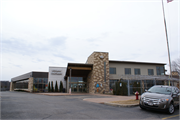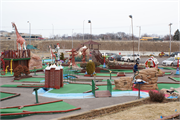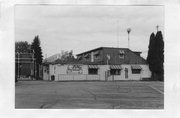| Additional Information: | A 'site file' exists for this property. It contains additional information such as correspondence, newspaper clippings, or historical information. It is a public record and may be viewed in person at the Wisconsin Historical Society, State Historic Preservation Office.
Some structures demolished prior to 2012 survey.
George Vitense Golfland is located on the southwest corner of Schroeder Road and Whitney Way. It is composed of a vernacular office building and golf shop, a driving range with 80 stalls, eight baseball/softball batting cages, a 9-hole course and two miniature golf courses: the California and the Wisconsin. The miniature golf courses are located in the northeast corner of the property. The office building stands just east and slightly south of the miniature courses. Practice greens and batting cages are arranged west of the miniature courses, close to Schroeder Road. The driving range is south of the office building and the 9-hole course occupies the west one-half to two-thirds of the site.
The office building is a long, one-story, exposed concrete block structure with a flat roof. It is an astylistic utilitarian structure and dates from 1958. A frame, aluminum-sided, second story was added to the north half of the building c. 1960. The second story houses a small apartment. It was built so that Vitense could live on site during the busy summer season. The building displays fixed and 1/1 windows.
George Vitense opened the Vitense Driving Range on this site in 1957. In 1958, he added the 9-hole course, the California miniature golf course, and the pro shop (which provided concessions). The Wisconsin course was created c. 1963, cited where a series of trampoline beds originally lay and incorporating some of the holes and whimsical creatures from the California course. At the far south end of the Wisconsin course, a new hole, which looks like a miniature mountain and includes a sliding bar that the player can hang from, has been added since 1995.
Dubbed, Golfland, all of it was lighted. George Vitense intended Golfland to be an affordable, family-oriented golfing place.
Vitense was significant in the development of golf as a recreational hobby in Madison and was one of the most prominent golf teachers in the state. Vitense (1904-1988) became a caddy at the Maple Bluff Country Club, by accident, in 1912. Then 8 years old, Vitense was picking cherries on the old Robert La Follette farm adjacent to the golf course, when an elderly golfer happened by and offered him 50 cents if Vitense would carry his clubs. Vitense worked as a caddy at Maple Bluff for 12 years, learning to golf and serving as the assistant professional at the course from 1920 to 1924. In 1924-5, Vitense was the golf pro at the Waupaca County Club. In 1926, he became the first golf pro at the Glenway Municipal Golf in Madison, staying until 1929. During this period, Vitense also built and operated a miniature golf course at 532-32 State Street, and taught golf at the University of Wisconsin. He is said to have pioneered group golfing lessons with his classes at the University. From 1929 until 1936, he was the golf pro at the Buttes des Morts Country Club in Appleton, but lost his job as a result of the Depression. Vitense relocated to Rockford briefly, where he sold insurance and cemetery plots. In 1939, Vitense returned to Madison and began a driving range on the site of what is now the Hartmeyer Ice Arena. The driving range prospered, inspiring Vitense to lease the Nakoma Country Club golf course and club house, then defunct. From 1940 until 1947, he operated that facility, updating it and serving as the course's golf pro. The Nakoma Country Club was revived in the late 1940s and he took over management of the course in 1948.Vitense continued as the pro at Nakoma until 1958. In 1954, he opened the driving range at Vitense. When he expanded Golfland to include a 9-hole course and miniature range in 1958, Vitense retired from the Nakoma Country Club. In addition to being a fine golf teacher, Vitense was an excellent golfer. He was the Wisconsin Senior Golf Champion from 1954 to 1958 and won the National Senior PGA tournament held in West Palm Beach, Florida, in 1970. Vitense served as president of the Wisconsin Professional Golfers Association and was inducted into Madison's Sports Hall of Fame. George Vitense's ceaseless efforts over more than 60 years helped popularize miniature golf in Madison. |
|---|



